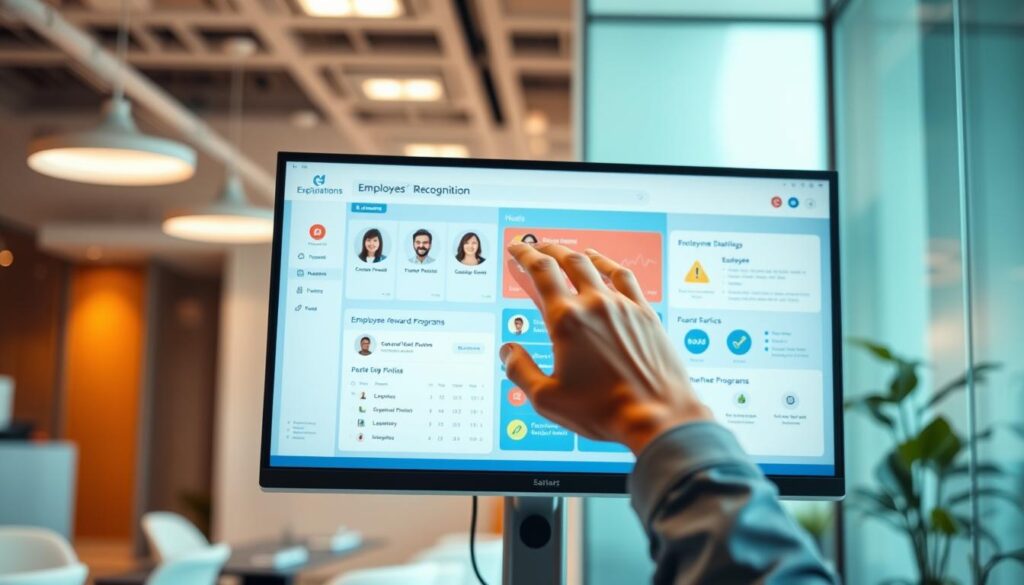Creating a culture of recognition is crucial for developing engaged and loyal employees. When you make employee appreciation integral to your workplace culture, you can foster an environment where employees feel valued and motivated.
By implementing meaningful and intentional practices, you can encourage employees to go above and beyond their regular duties. A genuine ‘thank you’ from management can ignite a significant increase in the likelihood of employees bringing their extra effort to work.
Table of Contents
Key Takeaways
- Cultivating a culture of recognition leads to more engaged and loyal employees.
- Employee appreciation should be integral to your workplace culture.
- Meaningful practices encourage employees to exceed their regular duties.
- A genuine ‘thank you’ can significantly boost employee effort.
- Recognised employees are more likely to drive innovation and bring new ideas forward.
The Value of Employee Recognition in Modern Workplaces
As organisations strive to create a more engaged and motivated workforce, the importance of employee recognition cannot be overstated. Employee recognition refers to all the ways an organisation shows its appreciation for employees’ contributions, which can significantly impact various aspects of the workplace.
Impact on Employee Engagement and Retention
Employee recognition plays a crucial role in enhancing employee engagement and retention. When employees feel valued and appreciated, they are more likely to be motivated and committed to their work. According to a study by Gallup, organisations with effective recognition programmes experience higher levels of employee engagement, which can lead to improved productivity and reduced turnover rates. You can learn more about the impact of employee recognition from Gallup’s research on employee recognition.
The Business Case for Recognition Programmes
Implementing a recognition programme can have a significant return on investment for organisations. By boosting employee morale and motivation, recognition programmes can lead to improved performance and reduced absenteeism. A well-designed recognition programme can also enhance the overall work environment, making it more attractive for top talent to join and stay with the organisation.
| Benefits of Employee Recognition | Impact on Organisation |
|---|---|
| Increased Employee Engagement | Improved Productivity |
| Enhanced Employee Retention | Reduced Turnover Costs |
| Better Work Environment | Attracts Top Talent |
The Psychology Behind Effective Recognition
Effective recognition is rooted in understanding the psychological needs of employees. When employees receive recognition that is meaningful and timely, it can boost their self-esteem and reinforce positive behaviours. This psychological impact can lead to a more positive and productive work environment, where employees feel valued and are more likely to contribute to the organisation’s success.
Understanding Different Types of Employee Recognition
Employee recognition comes in various forms, each with its unique benefits and applications in the workplace. Understanding these different types is crucial for creating an effective recognition strategy that boosts staff incentives and enhances employee motivation.
Formal vs Informal Recognition Approaches
Formal recognition involves structured programmes and events, such as annual awards ceremonies or regular acknowledgement meetings. Informal recognition, on the other hand, is more spontaneous and can occur through casual praise or acknowledgement in team meetings.
When to Use Each Type
Formal recognition is particularly effective for significant achievements or milestones, while informal recognition can be used daily to motivate employees and reinforce positive behaviours.
Individual vs Team-Based Recognition
Recognizing individual contributions can boost personal motivation and satisfaction, while team-based recognition fosters collaboration and unity among team members. A balanced approach that includes both can be particularly effective.
Monetary vs Non-Monetary Rewards
Monetary rewards, such as bonuses or gift cards, provide tangible benefits, whereas non-monetary rewards, like extra time off or professional development opportunities, can offer longer-term value and satisfaction.
Here’s a summary of the different types of employee recognition:
| Type of Recognition | Description | Benefits |
|---|---|---|
| Formal Recognition | Structured programmes and events | Effective for significant achievements, provides a sense of prestige |
| Informal Recognition | Spontaneous praise or acknowledgement | Motivates employees daily, reinforces positive behaviours |
| Individual Recognition | Recognizes personal contributions | Boosts personal motivation and satisfaction |
| Team-Based Recognition | Fosters collaboration among team members | Enhances unity and cooperation |
| Monetary Rewards | Bonuses, gift cards, etc. | Provides tangible benefits |
| Non-Monetary Rewards | Extra time off, professional development, etc. | Offers longer-term value and satisfaction |
By understanding and leveraging these different types of employee recognition, you can create a comprehensive recognition strategy that enhances staff incentives and boosts employee motivation.
Effective Methods for Recognising and Rewarding Employee Contributions
Employee recognition is a vital aspect of modern workplace culture, influencing both engagement and retention. Recognising staff efforts goes a long way toward showing people that they matter to the company, both as an employee and as a person. To effectively recognise and reward employee contributions, organisations can employ various strategies.
Verbal and Written Appreciation Techniques
Verbal appreciation, such as thanking employees directly or praising them in team meetings, can significantly boost morale. Written appreciation, including personalised emails or handwritten notes, provides a tangible record of recognition that employees can refer to later.
Public Recognition Opportunities
Public recognition opportunities, such as employee of the month awards or company-wide announcements, can enhance an employee’s sense of achievement. These public acknowledgments not only motivate the recognised employee but also encourage others to strive for similar recognition.
Tangible Rewards and Incentives
Tangible rewards offer a more concrete form of recognition. These can be categorised into several types:
Gift Cards and Vouchers
Gift cards and vouchers provide employees with the flexibility to choose their own rewards, making the recognition more personal and meaningful.
Experience-Based Rewards
Experience-based rewards, such as tickets to events or unique experiences, create lasting memories and can be a powerful motivator.
Professional Development Opportunities
Offering opportunities for professional development, such as training courses or conference attendance, demonstrates a commitment to employees’ future and can be a significant incentive.
| Reward Type | Examples | Benefits |
|---|---|---|
| Gift Cards and Vouchers | Retail, dining, or entertainment vouchers | Flexibility, personal choice |
| Experience-Based Rewards | Concert tickets, adventure activities | Creates lasting memories |
| Professional Development Opportunities | Training courses, conference attendance | Career advancement, skill enhancement |
By implementing these effective methods for recognising and rewarding employee contributions, organisations can foster a more engaged, motivated, and productive workforce.
Creating a Culture of Appreciation
To truly reap the benefits of employee recognition, organizations must cultivate a deep-seated culture of appreciation. This involves more than just occasional gestures of gratitude; it requires a consistent and genuine approach to valuing employees’ contributions.
Leading by Example: Management’s Role
Management plays a pivotal role in establishing a culture of appreciation. Leaders must set the tone by consistently demonstrating appreciation for their team members’ efforts. This can be achieved through regular feedback, public recognition, and leading by example. When managers show appreciation, it encourages a trickle-down effect, fostering a more positive and supportive work environment.
Embedding Recognition into Company Values
For a culture of appreciation to truly flourish, recognition must be embedded into the core values of the organization. This means incorporating appreciation into daily operations, performance reviews, and strategic planning. By doing so, organizations can ensure that recognition is not seen as an afterthought but as an integral part of the company culture.
Encouraging Peer-to-Peer Recognition
Peer-to-peer recognition is a powerful tool for building a culture of appreciation. By empowering employees to recognize and appreciate each other’s efforts, organizations can create a more collaborative and supportive work environment. This can be facilitated through digital platforms, team meetings, or simple gestures like thank-you notes.
By implementing these strategies, organizations can create a robust culture of appreciation that enhances employee engagement, retention, and overall workplace satisfaction.
Personalising Recognition to Individual Preferences
Employee recognition is not a one-size-fits-all approach; it requires tailoring to individual preferences for maximum impact. Different employees have different preferences when it comes to recognition, and understanding these differences is crucial for creating an effective recognition programme.
Understanding Employee Motivations
Understanding what motivates your employees is the first step in personalising recognition. Some employees are motivated by financial rewards, while others value public acknowledgement or additional time off. As personalization in website design can enhance user experience, personalizing recognition can significantly boost employee engagement.
To understand employee motivations, organisations can conduct surveys or one-on-one interviews to gather insights into individual preferences.
Tailoring Rewards to Different Personality Types
Different personality types respond to different types of rewards. For instance, introverted employees might prefer private recognition, while extroverted employees might thrive on public praise. According to a study, “recognition is a fundamental human need, and when it is not met, employees can feel undervalued and unappreciated.”
“The key to successful recognition is to make it personal, timely, and meaningful to the individual.”
Creating Meaningful Recognition Moments
Creating meaningful recognition moments involves more than just acknowledging an employee’s achievement; it’s about making the recognition relevant and significant to the individual. This can be achieved by tying the recognition to the company’s values or the employee’s personal goals.
By personalising recognition, organisations can foster a more inclusive and appreciative culture, leading to increased employee satisfaction and retention.
Implementing Cost-Effective Recognition Programmes
Implementing a recognition program doesn’t have to break the bank; there are numerous cost-effective strategies to appreciate your employees. You can create a culture of recognition that is both meaningful and budget-friendly.
Low-Cost Recognition Ideas That Make an Impact
There are several low-cost recognition ideas that can significantly impact employee morale and engagement. For instance, public acknowledgement through company-wide emails or newsletters can be very effective. You can also consider involving employees in decision-making processes as a form of recognition.
- Verbal appreciation during team meetings
- Personalised thank-you notes
- Employee of the month/quarter/year awards
These methods not only show appreciation but also encourage a positive work environment.
Maximising ROI on Recognition Initiatives
To maximise the return on investment (ROI) of your recognition initiatives, it’s essential to track their effectiveness. You can use metrics such as employee retention rates, productivity levels, and overall job satisfaction to gauge the impact of your recognition programs.
| Recognition Metric | Pre-Recognition Data | Post-Recognition Data |
|---|---|---|
| Employee Retention Rate | 75% | 85% |
| Productivity Levels | 80% | 90% |
| Job Satisfaction | 70% | 85% |
By analysing these metrics, you can refine your recognition strategies to achieve better outcomes.
“The key to successful recognition is not the price tag but the thought and sincerity behind it.”
Technology and Tools for Modern Employee Recognition
Technology has transformed the landscape of employee recognition, offering various tools and platforms to acknowledge staff contributions. As organisations strive to boost employee motivation and appreciation, leveraging technology has become increasingly crucial.
Digital Platforms and Apps for Recognition
Digital platforms and apps have made it easier for organisations to implement employee recognition programmes. These tools offer features such as peer-to-peer recognition, reward systems, and analytics to track the effectiveness of recognition initiatives. For instance, platforms like employee engagement tools can be integrated into existing HR systems to streamline recognition processes.
| Feature | Description | Benefits |
|---|---|---|
| Peer-to-Peer Recognition | Allows employees to recognise each other’s efforts | Enhances team collaboration and morale |
| Reward Systems | Offers tangible rewards for achievements | Motivates employees to perform better |
| Analytics | Tracks the effectiveness of recognition programmes | Helps in refining recognition strategies |
Integrating Recognition into Existing Systems
Integrating employee recognition into existing HR systems is vital for seamless execution. This integration enables organisations to manage recognition programmes alongside other HR functions, such as performance management and employee development. By doing so, organisations can create a holistic approach to employee engagement and motivation.
Using Data to Drive Recognition Strategies
Using data analytics is crucial in driving effective recognition strategies. By analysing data on employee recognition, organisations can identify trends, preferences, and areas for improvement. This data-driven approach enables organisations to tailor their recognition programmes to better meet the needs of their employees, thereby enhancing employee appreciation and motivation.
Common Pitfalls to Avoid When Recognising Staff Efforts
Effective employee recognition requires more than just good intentions; it demands a thoughtful approach that avoids common pitfalls. As you strive to create a culture of appreciation, it’s crucial to be aware of the potential mistakes that can undermine your efforts.
Generic or Impersonal Recognition
One of the most significant pitfalls is offering generic or impersonal recognition. When recognition is not tailored to the individual, it can come across as insincere or dismissive of the employee’s unique contributions. To avoid this, take the time to understand what motivates each team member and personalise your recognition efforts accordingly.
Inconsistent or Inequitable Recognition Practices
Inconsistent or inequitable recognition practices can lead to feelings of unfairness and resentment among employees. It’s essential to establish clear criteria for recognition and apply them consistently across the organisation. Regularly reviewing and adjusting your recognition practices can help ensure equity and maintain trust.
| Best Practices | Common Pitfalls |
|---|---|
| Personalised recognition | Generic or impersonal recognition |
| Consistent application of recognition criteria | Inconsistent or biased recognition practices |
| Alignment with company values | Recognition that contradicts company values |
Failing to Match Recognition with Company Values
Recognition that is not aligned with company values can send mixed messages and undermine the organisational culture. Ensure that your recognition efforts reinforce the values and behaviours that are most important to your organisation. For more insights on avoiding common recognition mistakes, visit Nectar HR’s blog on employee recognition.
By being aware of these common pitfalls and taking steps to avoid them, you can create a more effective and meaningful recognition programme that truly values your employees’ contributions.
Conclusion: Building a Sustainable Culture of Recognition
Building a sustainable culture of recognition requires ongoing effort and commitment to rewarding staff performance effectively. A well-implemented recognition program can significantly boost employee engagement, leading to improved organisational success.
Research involving 25,285 employees has shown that recognition, fairness, and involvement have a positive effect on engagement. Transformational leadership and manageable workloads also contribute to higher engagement levels, while burnout and technological disruption anxiety negatively impact satisfaction.
To foster a culture of appreciation, organisations should prioritise personalised recognition, leveraging digital platforms and data-driven insights to inform their strategies. By avoiding common pitfalls such as generic or impersonal recognition, organisations can create a meaningful and impactful recognition culture.
Ultimately, a sustainable culture of recognition is crucial for driving employee engagement and organisational success. By understanding the factors that influence engagement and satisfaction, organisations can develop targeted strategies to enhance their recognition programs and improve overall performance.
FAQ
What is the importance of recognising and rewarding employee contributions?
Recognising and rewarding employee contributions is crucial as it leads to more engaged and loyal employees, ultimately driving organisational success.
How does employee recognition impact employee engagement and retention?
Employee recognition has a positive impact on employee engagement and retention by making employees feel valued and appreciated, leading to increased job satisfaction and reduced turnover rates.
What are the different types of employee recognition?
The different types of employee recognition include formal and informal approaches, individual and team-based recognition, and monetary versus non-monetary rewards.
How can I personalise recognition to individual preferences?
You can personalise recognition by understanding what motivates different employees, tailoring rewards to different personality types, and creating meaningful recognition moments.
What are some cost-effective ways to implement recognition programmes?
Cost-effective ways to implement recognition programmes include low-cost ideas such as verbal and written appreciation, public recognition opportunities, and experience-based rewards.
How can technology aid in employee recognition?
Technology can aid in employee recognition through digital platforms and apps, integrating recognition into existing HR systems, and using data to inform recognition strategies.
What are some common pitfalls to avoid when recognising staff efforts?
Common pitfalls to avoid include generic or impersonal recognition, inconsistent or inequitable recognition practices, and failing to align recognition with company values.
How can I create a culture of appreciation within my organisation?
You can create a culture of appreciation by leading by example, embedding recognition into company values, and encouraging peer-to-peer recognition.
What is the role of management in employee recognition?
Management plays a crucial role in employee recognition by setting the tone for a culture of appreciation, leading by example, and ensuring that recognition is consistent and aligned with company values.
How can I measure the effectiveness of my recognition programme?
You can measure the effectiveness of your recognition programme by tracking employee engagement, retention rates, and feedback, as well as using data to inform recognition strategies.











